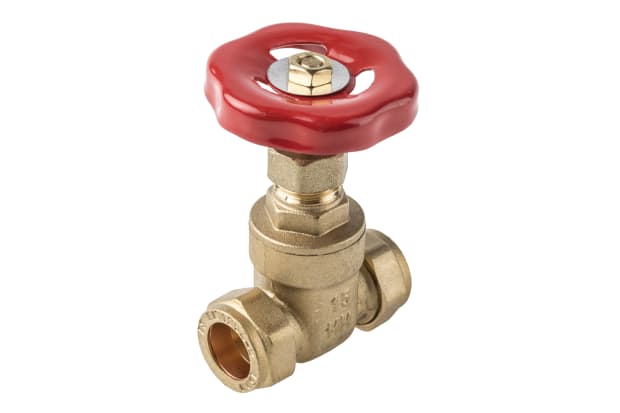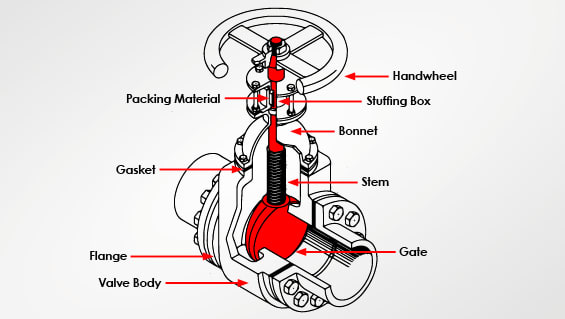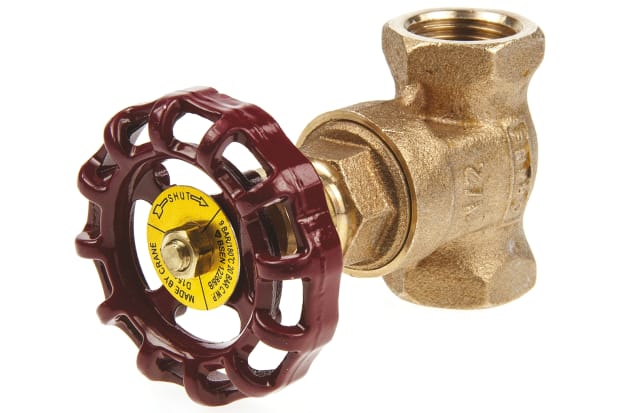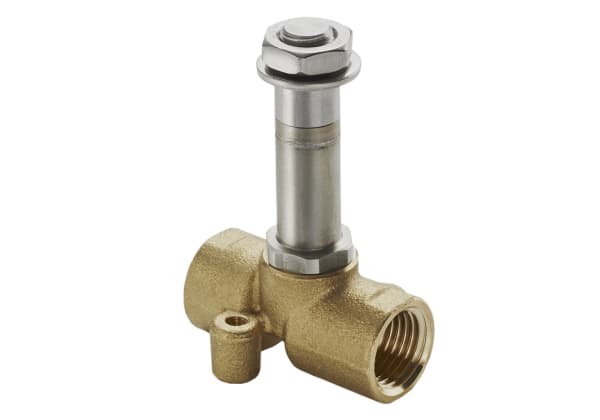- Published 1 Feb 2023
- Last Modified 29 Aug 2023
- 10 min
A Complete Guide to Gate Valves
Our gate valves guide explains their uses, how they work, the different types, and how to use them correctly.

Reviewed by David Carmichael, Solution Engineer (October 2021)
What is a Gate Valve?
Gate valves are a common linear valve type found in pipelines, both above and below ground. A gate valve is designed to start and stop the flow of liquid through ducting, allowing users to isolate a section of pipe when required. They are often called water gate valves or sluice valves.
When people ask what is a gate valve, they will often have follow-up requests for more information on what gate valves look like, what parts they include, the differences between various types, and exactly how they work. We will cover all of these areas in the various sections of this guide.
Gate valves usually consist of the valve body itself, which is installed in-line (through-conduit) on a length of pipe, and an attached handwheel actuator used for opening and closing the valve. This multi-turn wheel assembly most often extends above or to the side of the pipe and valve, attached to a bonnet assembly via a stem. It can be turned in one direction to open the valve, and in the opposite direction to close it.
The advantages of a gate valve are that they provide complete shut-off of any water flow for troubleshooting, maintenance and pipe-cleaning tasks. They are also bidirectional, meaning they can be used to block flow in both upstream and downstream directions, and they do not cause significant pressure loss in operation.
Limitations of gate valves in certain scenarios may include the fact that they are not especially quick to open or close. Additionally, they are not designed to throttle or control flow by being partially opened or shut.
This guide is designed to explain in more detail what gate valves are, what they are used for, how they work, and the different types of UK gate valves available to buy online. We will also briefly outline how to use them, as well as providing some clear and concise answers to common questions about gate valves. By the end of the guide, readers will be familiar with what sluice valves are, how they work, and why they are used.
What are Gate Valves Used for?
Most types of gate valve can be thought of simply as a sluice valve or control valve for water supply. Gate valves are used for starting or stopping the flow of liquid (or steam/gas) through a section of pipeline, allowing that section to be completely shut off and isolated when necessary.
They are among the most common sorts of valves and taps you will find in most pipeline applications, and are used in a wide range of industrial settings. These might typically include:
- Oil and gas extraction
- Processing plants and water treatment facilities
- Various types of factories and production environments
- Medical and laboratory uses
- Food production and catering
- Automotive and mechanical
- Marine and offshore uses
Certain types of gate valves are often suitable choices for both high pressure and high temperature applications. Although quite a simple sort of valve in principle, they are highly effective when used in the right circumstances. Being fire-safe also means they are a suitable choice for high pressure-temperature scenarios.
Unlike some other types of shutoff valves (such as globe valves), a gate valve is only intended to be used in its fully open or fully closed state. Leaving it in a partially raised or lowered position will not have much effect on controlling the flow rate of the medium in the pipe, and may risk moving or damaging the valve due to excessive vibration.
How Does a Gate Valve Work?

Gate valves work by inserting a physical barrier (the gate or disk) into the pipeline, sealing it when closed, and lifting it out of the way when opened. This barrier is raised or lowered via a handwheel on the valve bonnet, which serves as the valve actuator. It turns clockwise and anticlockwise to start or stop the liquid flow as required.
In short, a gate valve is a type of handwheel operated isolation valve or shutoff valve. The handwheel actuation system might be connected via either a rising-stem or non-rising stem design. Stainless steel, iron body and brass gate valves are widely used in all manner of plumbing and pipeline applications, thanks to their effectiveness and ease of use. They are also reliable, mechanically quite simple, and usually fairly cheap to buy, depending on size, model and brand.
Another common type of isolation valve is a ball valve, which is somewhat different from a gate valve in terms of its physical construction. However, both will achieve a similar effect in the sense that they will completely block the flow of water through a duct when fully closed. There are numerous key factors involved in deciding between a ball valve vs. a gate valve for a given pipeline application or industrial setting. These will normally include the sorts of environmental conditions they are being used in, and the properties of the medium where they are controlling the flow.
Gate valves should also be distinguished from check valves, another familiar pipeline device used to control directional flow, and butterfly valves. The main difference between check valves and gate valves is that the former is designed to prevent backflow; they allow unhindered flow in one direction while blocking it in the opposite direction. By contrast, gate valves are bidirectional, and will completely shut off the flow of fluid, vapour or gas in both directions when in a closed position.
A butterfly valve is a variation of a gate or isolation valve. They usually require just a quarter-turn of the valve actuator handle to open or close. The gate itself sits either parallel or perpendicular to the flow direction inside the pipe, depending on the position of the actuation device relative to the valve body. They are generally less suitable than gate valves in situations where achieving a very tight seal is critical, but some versions can be used to throttle.
The two main types of gate valves are wedge-shaped and parallel. Wedge-shaped gate valves (including solid taper wedge, flexible wedge and split wedge designs) use two inclined seats and an inclined gate or barrier, which is intentionally slightly misaligned with the seats. This tends to achieve a tighter seal than a parallel version in certain applications. Parallel gate valves, sometimes called parallel disks, double disks or parallel slide gate valves, have a flat gate or barrier held perpendicular to the flow of liquid between two parallel seats.
Gate Valve Diagram
This is a cut-out diagram showing typical parts of a gate valve, giving you a visual indication of its basic components, stem design and function.
Key parts such as the bonnet, stem, seal rings and valve body are labelled for clearer identification.
Image: RS

Gate Valve Types
There are various sorts of gate valves used in numerous applications across a wide range of pipeline and workplace types. Below, we have listed some of the most popular types of gate valves on sale in the UK and elsewhere, with a brief description of each kind.
Wedge Gate Valves
A wedge gate valve is one of the more common types you will find in widespread use across all relevant plumbing and industrial pipeline setups. Subtypes include the solid wedge, the flexible wedge, and the split wedge.
Solid wedge gate valves (or plain wedge valves) tend to be the most widely used. They are often among the simplest and cheapest options but offer good mechanical strength. They are broadly suitable for nearly all types of fluid media. Their robust, single-piece construction makes them especially appropriate for use in pipelines with turbulent fluid flow.
In wedge valves, the barrier or gate is slightly inclined against the flow path of pressurised liquid in the pipe. For this reason, they are also referred to as tapered gates. This angle creates a wedging force as the valve closes, and helps to make for a more reliable seal at higher fluid pressure ratings.
Split Gate Valves
A split gate valve, or split wedge gate valve, is a type of wedge valve in which the wedge disk itself is made from two solid pieces, held in place by a spacer or spring. This gives it the ability to self-adjust to the seats, providing added flexibility and making it easier to achieve a tighter seal with less risk of sticking or binding. They are particularly suitable for use with non-condensing gases and corrosive liquids.
Parallel Gate Valves
A parallel gate valve (sometimes called a parallel disk gate valve, or parallel slide gate valve) operates in much the same way as a wedge gate valve, but the gate features two disks placed at a 90-degree angle to the fluid flow direction. They are generally seen as safer in high temperature applications, where the parallel design is less likely to result in thermal binding.
Knife Gate Valves
A knife gate valve is a well-known type that is designed primarily for use with very thick or viscous fluids, such as slurry or powder-carrying liquid. The disks in the knife gate valve model are tapered (effectively sharpened, hence knife valves) at one end to enable them to cut and move through thicker media more easily when closing.
Flanged Gate Valves
A flanged gate valve is one where the body of the valve is flanged and bolted to the bonnet (the part on top of the valve through which the handwheel assembly connects, and which gives access to the moving parts of the valve). This tends to make them better suited to higher pressure applications than screwed connections, but less ideal than specialist pressure sealing models.
How to Use a Gate Valve
Gate valve operation is simple, only requiring the user to turn the handwheel in the correct direction to open or close the valve as necessary. Closing or opening a gate valve involves rotating the wheel through 360 degrees in the required direction - this, in turn, rotates the threaded valve stem, and thus raises or lowers the attached gate disk.

How to Tell If a Gate Valve is Open or Closed
Unlike with certain other flow valve types, it is not always easy to tell whether a gate valve is open or not. Ball valves and butterfly valves, for example, will usually be closed when the handle is perpendicular to the pipeline or flow direction.
Since gate valve wheels sit above or to the side of the pipe and rotate through 360 degrees to open and close, you cannot always tell which position they are in at a glance. In most cases, turning a gate valve anticlockwise will open it, while turning it clockwise will close it. These directions will normally be marked on the handwheel or elsewhere on the outer body of the valve.
Unless you know for a fact that a gate valve is jammed or bound, you should always stop turning them when you start to feel significant resistance. Continuing to turn a gate valve against resistance can damage it, or the plumbing or ducting it is installed on. It may therefore be necessary to try turning a gate valve in either direction to ascertain which position it is currently in.
Gate Valve Manufacturers
Gate valve manufacturers known for producing reliable, high-quality products include Conex-Banninger, Pegler Yorkshire, and Sferaco. Pegler gate valves in particular are often a go-to name in numerous industries for their sturdy construction, affordable pricing and good overall durability.
We work with all of the above suppliers to source our comprehensive range of gate valve products, including flanged and knife gate valves manufactured from various hardwearing materials such as brass and stainless steel. We also produce our own equally robust products under our own in-house RS PRO line, offering you even better value for money at the same exacting quality standards.

